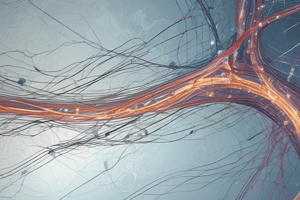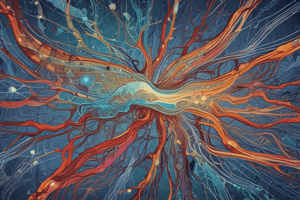Podcast
Questions and Answers
What is the primary function of electrical and chemical signals in neurons?
What is the primary function of electrical and chemical signals in neurons?
- To communicate information within and between neurons (correct)
- To control the production of ion channels
- To regulate the resting membrane potential
- To inhibit the action of graded potentials
What determines the distance over which communication can occur between neurons?
What determines the distance over which communication can occur between neurons?
- The type of ion channels present
- The type of potential, action or graded (correct)
- The strength of the electrical signal
- The quantity of charge on the neuron's membrane
What is the direction of ion movement through open ion channels?
What is the direction of ion movement through open ion channels?
- Along the plasma membrane
- Against their electrochemical gradient
- Across the cell membrane, but not down a gradient
- Down their electrochemical gradient (correct)
What is the net charge on the outside of a neuron's membrane at rest?
What is the net charge on the outside of a neuron's membrane at rest?
What is the relationship between the quantity of charge and the electric force of attraction?
What is the relationship between the quantity of charge and the electric force of attraction?
What is the primary difference between action potentials and graded potentials?
What is the primary difference between action potentials and graded potentials?
What is the primary function of Voltage-gated channels in the nervous system?
What is the primary function of Voltage-gated channels in the nervous system?
What is the main difference between myelinated and unmyelinated neurons?
What is the main difference between myelinated and unmyelinated neurons?
How does temperature affect the speed of action potential propagation?
How does temperature affect the speed of action potential propagation?
What is the purpose of gap junctions in electrical synapses?
What is the purpose of gap junctions in electrical synapses?
What determines the resting membrane potential?
What determines the resting membrane potential?
What is the function of metabotropic receptors?
What is the function of metabotropic receptors?
What is the role of the Na+/K+ pump?
What is the role of the Na+/K+ pump?
What is the term for the ability of a single neuron to synapse with many other post-synaptic cells?
What is the term for the ability of a single neuron to synapse with many other post-synaptic cells?
What is the name of the structure that joins the plasma membranes of two cells in an electrical synapse?
What is the name of the structure that joins the plasma membranes of two cells in an electrical synapse?
What type of ion channel is gated by a mechanical stimulus?
What type of ion channel is gated by a mechanical stimulus?
What is the primary mechanism by which ionotropic receptors contribute to the generation of an action potential?
What is the primary mechanism by which ionotropic receptors contribute to the generation of an action potential?
What is the direction of the net flux of K+ and Na+ ions?
What is the direction of the net flux of K+ and Na+ ions?
What is the term for the delay between the time the neurotransmitter is released and the time the postsynaptic potential is produced?
What is the term for the delay between the time the neurotransmitter is released and the time the postsynaptic potential is produced?
What is the term for the type of receptors that contain a neurotransmitter binding site and an ion channel?
What is the term for the type of receptors that contain a neurotransmitter binding site and an ion channel?
What is the effect of graded potentials on the membrane potential?
What is the effect of graded potentials on the membrane potential?
Which of the following is NOT a mechanism of neurotransmitter removal from the synaptic cleft?
Which of the following is NOT a mechanism of neurotransmitter removal from the synaptic cleft?
What is the term for the sum of the effects of multiple excitatory and inhibitory postsynaptic potentials?
What is the term for the sum of the effects of multiple excitatory and inhibitory postsynaptic potentials?
What is the purpose of the axon hillock?
What is the purpose of the axon hillock?
What is the primary effect of a neurotransmitter agonist on neurotransmission?
What is the primary effect of a neurotransmitter agonist on neurotransmission?
What is the primary mechanism of action of neuromodulators?
What is the primary mechanism of action of neuromodulators?
What is the threshold potential for depolarization?
What is the threshold potential for depolarization?
Which of the following drugs is an example of a neurotransmitter antagonist?
Which of the following drugs is an example of a neurotransmitter antagonist?
What is the sequence of events in an action potential?
What is the sequence of events in an action potential?
What is the significance of the refractory period?
What is the significance of the refractory period?
What is the primary effect of opioids on their target neurons?
What is the primary effect of opioids on their target neurons?
What is the purpose of temporal and spatial summation?
What is the purpose of temporal and spatial summation?
Flashcards
Neurotransmitter effect
Neurotransmitter effect
The same neurotransmitter can have different effects depending on the receptor it binds to.
Acetylcholine receptors
Acetylcholine receptors
Acetylcholine (ACh) binds to both ionotropic and metabotropic receptors.
Ionotropic receptors
Ionotropic receptors
These receptors allow the influx of positively charged ions, leading to depolarization, and excitatory effects.
Metabotropic receptors
Metabotropic receptors
Signup and view all the flashcards
Neurotransmitter removal
Neurotransmitter removal
Signup and view all the flashcards
Drug action on synapse
Drug action on synapse
Signup and view all the flashcards
Neurotransmitter agonist
Neurotransmitter agonist
Signup and view all the flashcards
Neurotransmitter antagonist
Neurotransmitter antagonist
Signup and view all the flashcards
Neuromodulators
Neuromodulators
Signup and view all the flashcards
Ion channels
Ion channels
Signup and view all the flashcards
Leak channels
Leak channels
Signup and view all the flashcards
Ligand-gated channels
Ligand-gated channels
Signup and view all the flashcards
Mechanically-gated channels
Mechanically-gated channels
Signup and view all the flashcards
Voltage-gated channels
Voltage-gated channels
Signup and view all the flashcards
Resting membrane potential
Resting membrane potential
Signup and view all the flashcards
Graded potentials
Graded potentials
Signup and view all the flashcards
Action potentials
Action potentials
Signup and view all the flashcards
Synapse
Synapse
Signup and view all the flashcards
Electrical synapse
Electrical synapse
Signup and view all the flashcards
Chemical synapse
Chemical synapse
Signup and view all the flashcards
Action potential mechanism
Action potential mechanism
Signup and view all the flashcards
Threshold potential
Threshold potential
Signup and view all the flashcards
Neuron communication
Neuron communication
Signup and view all the flashcards
Study Notes
Neurotransmitters and Their Effects
- Same neurotransmitter can have different effects depending on the receptor it binds to
- Acetylcholine (Ach) binds to ionotropic and metabotropic receptors:
- Ionotropic receptors (e.g., nicotinic acetylcholine receptors) allow influx of positively charged ions, leading to depolarization and excitatory effects
- Metabotropic receptors (e.g., muscarinic acetylcholine receptors) trigger intracellular signaling cascades, leading to inhibitory effects
Neurotransmitter Removal
- Neurotransmitters can be removed from the synaptic cleft by:
- Diffusion
- Enzymatic degradation
- Uptake into cells (reuptake or uptake into neighboring neuroglia)
Action of Drugs on the Chemical Synapse
- Drugs can:
- Increase leakage of neurotransmitter from vesicle to cytoplasm
- Increase neurotransmitter release into the cleft
- Block neurotransmitter release
- Inhibit transmitter synthesis
- Block neurotransmitter reuptake
- Block cleft enzymes that metabolize neurotransmitters
- Bind to receptors on the post-synaptic membrane
- Inhibit or stimulate second-messenger activity in the post-synaptic cell
Neurotransmitter Agonists and Antagonists
- Neurotransmitter agonists:
- Mimic the action of endogenous neurotransmitters
- Enhance neurotransmission
- Bind to receptors on the post-synaptic neuron, leading to an excitatory response
- Examples: L-DOPA (levodopa) for treatment of Parkinson's disease
- Neurotransmitter antagonists:
- Block the action of endogenous neurotransmitters
- Bind to receptors, preventing the neurotransmitter from exerting its usual effect
- Result in inhibitory responses
- Examples: Haloperidol for treatment of Schizophrenia
Neuromodulators
- Modulate synaptic transmission by influencing the release or reuptake of neurotransmitters
- Examples: Opioids, which can alter the electrical properties of target neurons and induce pain relief, euphoria, and other effects
Ion Channels
- Types of ion channels:
- Leak channels
- Ligand-gated channels
- Mechanically-gated channels
- Voltage-gated channels
- Ion channels open and close due to "gates" that can seal the channel pore shut or open it up
- Ion channels allow specific ions to move across the plasma membrane down their electrochemical gradient
Resting Membrane Potential
- Determined by:
- Unequal distribution of ions across the plasma membrane
- Selective permeability of the neuron's membrane to Na+ and K+
- Na+/K+ pump
- Net flux of ions across membranes depends on both the concentration gradient and the electrical difference (electrochemical gradient)
Graded Potentials
- Small, transient changes in membrane potential confined to a small region of the plasma membrane
- Provide signaling in short distances
- Can be depolarizing (excitatory) or hyperpolarizing (inhibitory)
- Magnitude of the transient changes in membrane potential can vary
- Dependent on changes in membrane permeability to ions (ligand-gated ion channels)
Action Potentials
- Sequence of rapidly occurring events that decrease and eventually reverse the membrane potential (depolarization) and eventually restore it to the resting state (repolarization)
- Large changes in membrane potential of excitable cells only
- Membrane potential can change from -70mV to +40mV
- Depolarization, overshoot, repolarization, hyperpolarization, and return to resting membrane potential
Mechanism of Action of Action Potentials
- Initiated at the axon hillock (trigger zone)
- All-or-none event
- Depolarization needs to exceed the threshold potential
- CNS physiology and electrical signals in neurons
Electrical Signals in Neurons
- Information is carried within neurons and from neurons to their target cells by electrical and chemical signals
- Excitable cells communicate with each other via action potentials or graded potentials
- Action potentials allow communication over short and long distances, while graded potentials allow communication over short distances only
Synapse
- Anatomically specialized junction between two cells
- One single neuron can synapse onto many other post-synaptic cells (divergence)
- Many synapses from different presynaptic neurons can synapse with a single cell (convergence)
- Functional anatomy of the nervous system synapse:
- Electrical synapse (gap junction)
- Chemical synapse (operates through the release of neurotransmitters)
Studying That Suits You
Use AI to generate personalized quizzes and flashcards to suit your learning preferences.




